![]() Sources
Sources
![]() Illustrations
Illustrations
| Back to . . . |
This section . . .
|
|
|
An oil painting (23.5 x 30 centimeters) depicting Cicero discovering the tomb of Archimedes by the Austrian baroque painter Martin Knoller (1725-1804). It was painted in 1775 and is now located in a private collection in Mannheim, Germany.
Enlarged images: The WebMaster expresses his appreciation to the owner of this painting for bringing it to his attention and making its image available. |
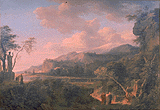
|
An oil painting (“Ciceron Decouvrant le Tombeau d'Archimede,” 119 x 162 centimeters) by the French painter Pierre Henri de Valenciennes (1750-1819), painted in 1787 and now housed in the Musée des Augustins (Toulouse, France).
An enlarged image of this painting (180 kilobytes, 701 x 482 pixels) can be viewed from a Web site maintained by the Ministère de la culture in France.
|
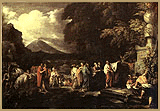
|
An oil painting (“Cicero Discovering the Tomb of Archimedes,” 124.5 x 180.5 centimeters) by the American painter Benjamin West (1738-1820), painted in 1797 and now located in a private collection. West painted a second slightly different version in 1804 that is now part of the Yale University Art Gallery collection (New Haven, Connecticut, USA).
Reference: The Paintings of Benjamin West by Helmut von Erffa and Allen Staley, Yale University Press, New Haven & London, 1986, (Catalog Numbers 22 and 23).
Enlarged images: |
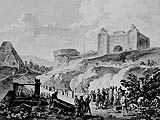
|
An engraving depicting Cicero discovering the tomb of Archimedes after a drawing by the French painter Hubert Robert (1733-1808). It appeared in J. C. Richard de Saint-Non’s travel book Voyage pittoresque ou description des royaumes de Naples et de Sicile, published in Paris between 1781 and 1786.
Enlarged image: 79 kilobytes, 640 x 480 pixels, 256 grayscales. |

|
An engraved frontispiece of a German translation of Cicero's Tusculan Disputations depicting Cicero discovering the tomb of Archimedes. The translation was by Xaver Weinzierl and was published in Munich in 1806.
Reference: “Archimedes’s Tomb and the Artists,” by J. B. Trapp, Journal of the Warburg and Courtauld Institutes, Volume 53, 1990, pages 286-288.
Enlarged image: 89 kilobytes, 305 x 480 pixels, 256 grayscales. |
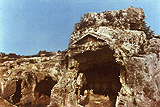
|
A tomb in Syracuse in the Necropolis of Grotticelli referred to affectionately (or deceptively) as “Archimedes’ Tomb ”, but known to be of Roman origin dating at least two centuries after the death of Archimedes.
Enlarged image: 95 kilobytes, 640 x 427 pixels. Also available:
|
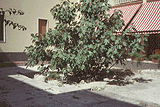 Photograph taken by the WebMaster in 1999. (Enlarged image: 79 kilobytes, 640 x 427 pixels.)
Photograph taken by the WebMaster in 1999. (Enlarged image: 79 kilobytes, 640 x 427 pixels.)
|
References for and against the authenticity of the site:
|